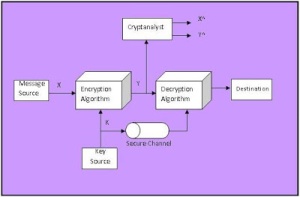Model of Conventional Cryptosystems
The following figure, which is on the next page, illustrates the conventional encryption process. The original “plaintext” is converted into apparently random nonsense, called “ciphertext”. The encryption process consists of an algorithm and a key. The key is a value independent of the plaintext. The algorithm will produce a different output depending on the specific key being used at the time. Changing the key changes the output of the algorithm, i.e., the ciphertext.
Once the ciphertext is produced, it may be transmitted. Upon reception, the ciphertext can be transformed back to the original plaintext by using a decryption algorithm and the same key that was used for encryption.
Model of Conventional Cryptosystem
The security of conventional encryption depends on several factors:
The Encryption Algorithm- It must be powerful enough that it is impractical to decrypt a message on the basis of the ciphertext alon
The intended receiver, in possession of the key is able to invert the transformation
X=Dk (Y)
An opponent, observing Y but not having access to K or X, may attempt to recover X or K or both X and K. It is assumed that the opponent knows the encryption (E) and decryption (D) algorithms. If the opponent is interested in only this particular message, then the focus of the effort is to recover X by generating a plaintext estimate X^. Often, however, the opponent is interested in being able to read future messages as well, in which case an attempt is made to recover K by generating an estimate K^.
